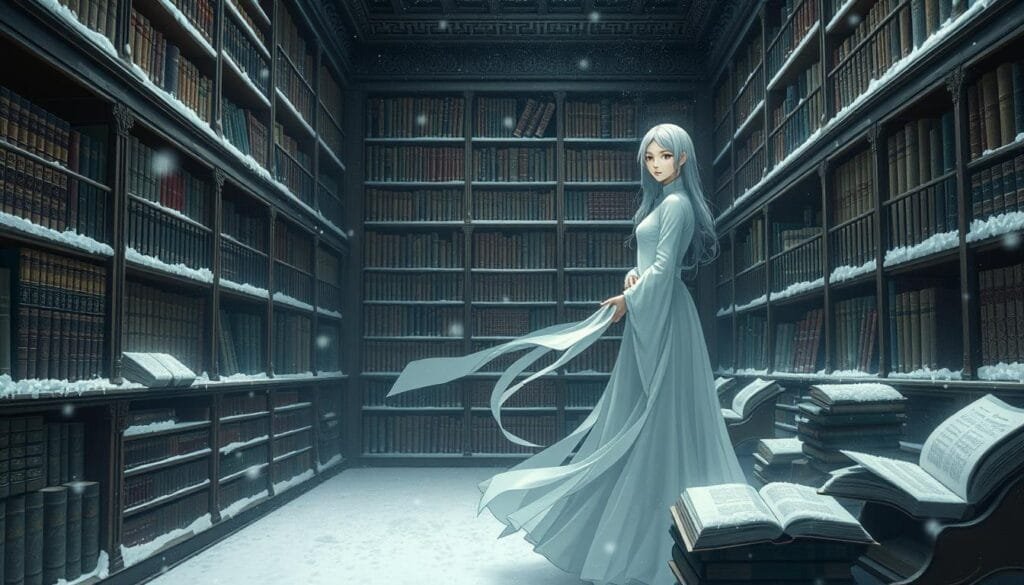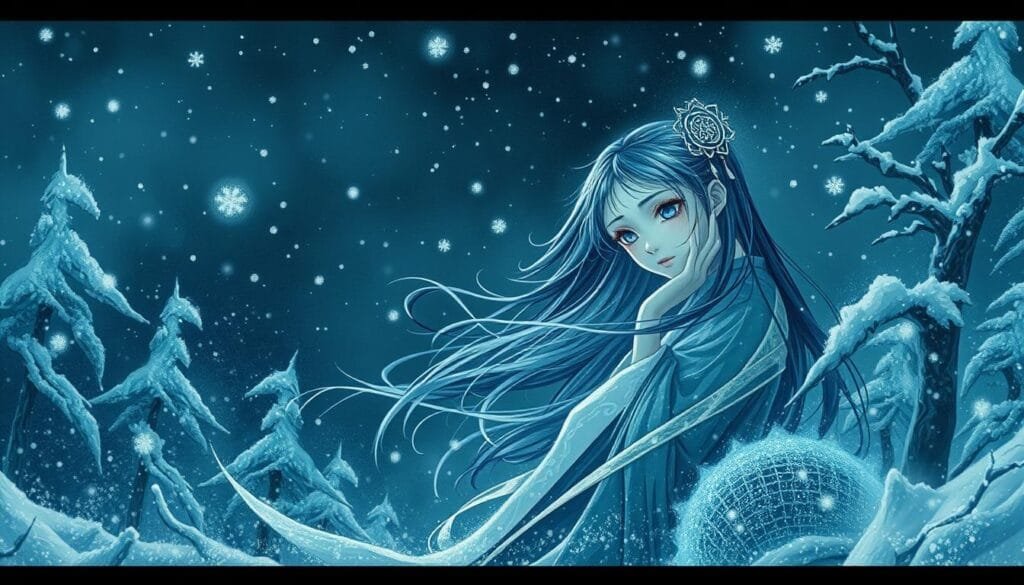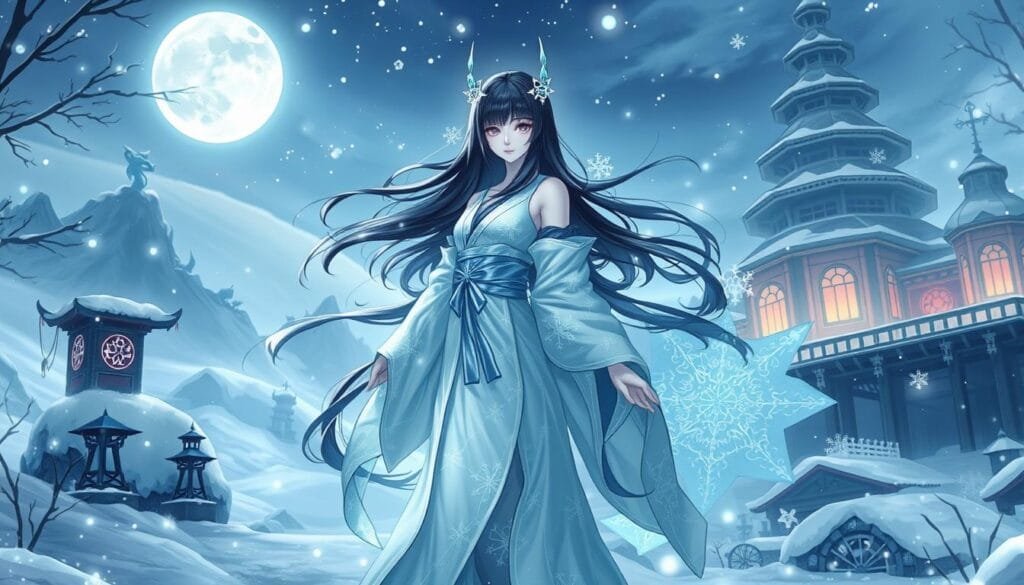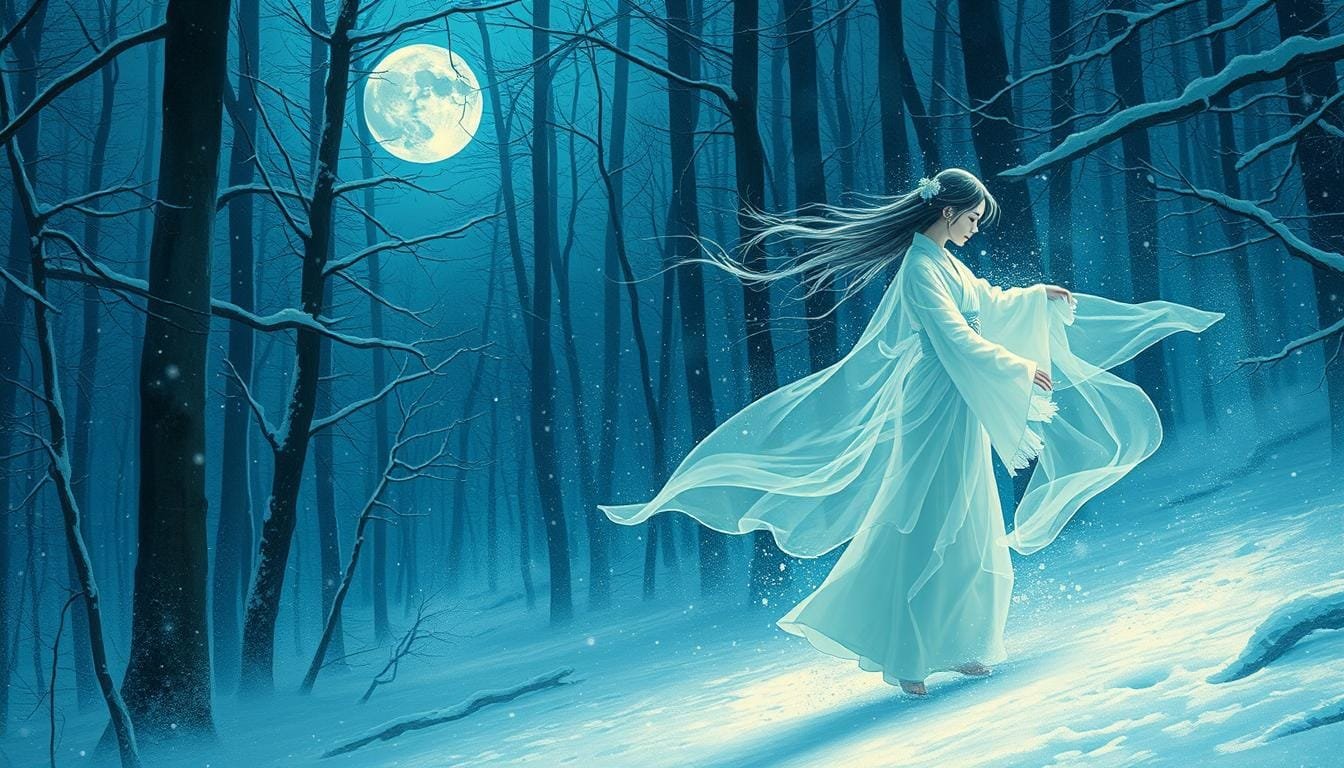Ever wondered how a mysterious figure from old Japanese tales found her way into today’s popular culture worldwide?
The Yuki Onna, or snow woman, fascinates us in Japanese stories. Known for her link to snow and the cold, she shows up in many forms of pop culture. From old books to the latest video games, Yuki Onna’s spirit has been brought to life in many ways. These reflect different views and art styles. Let’s look at how Yuki Onna continues to leave her mark in pop culture and media.
Key Takeaways
- The Yuki Onna, noted first in the Muromachi period (1333-1573), still stands out in today’s media.
- Stories portray her in varying lights, from good to evil, in books, movies, and video games.
- Yuki Onna appears in famous works like “Kwaidan” by Lafcadio Hearn and its film version by Masaki Kobayashi.
- Her image can be seen in anime, manga, and TV shows around the world.
- She symbolizes winter, beauty, and danger, keeping her a captivating character in stories.
Introduction to Yuki Onna
The enigma of Yuki Onna is a fascinating aspect of Japanese folklore. She comes from the cold Muromachi period. Yuki Onna, or the Snow Woman, shows the beauty and danger of winter. She is seen as a stunning ghostly figure gliding through snow, captivating and terrifying onlookers.
Exploring Yuki Onna’s past takes us deep into ancient Japanese tales. The zen monk Sōgi first mentioned her in the 15th century. She is often shown as a woman in white, shining like fresh snow in Tohoku’s cold winters. About 70% of stories describe her pale beauty, reflecting Japan’s beauty ideals.
The myths of Yuki Onna are found across different prefectures, each adding unique twists. In Niigata Prefecture, she freezes children. Yet, in Aomori and Yamagata Prefectures, her stories involve local people, adding charm to her lore.
Yuki Onna in folklore is more than just a source of fear. She represents nature’s dual aspects: peaceful yet harsh, lovely yet deadly. Her tales, like those translated by Patrick Hearn in 1904, still fascinate people today. They show her deep cultural impact.
Themes of trust and betrayal are common in Yuki Onna stories, teaching moral lessons. The legend of Minokichi and Yuki Onna focuses on promises. This character symbolizes winter’s mysteries and its fleeting beauty.
To give a clearer view of Yuki Onna’s traits and how they vary by region, see this table:
| Region | Yuki Onna Characteristic |
|---|---|
| Tohoku | Emphasis on beauty and winter storms |
| Niigata | Malevolence, freezing children to death |
| Aomori | Interactions with local inhabitants |
| Yamagata | Interaction with elderly couples |
| Nagano | Identified as “yukionba” |
| Fukui | Known as “koshi-musume” |
Yuki Onna in Literature
Yuki Onna appears in many stories as a beautiful yet haunting ice spirit. Her chilling beauty and demeanor captivate readers. She is common in both old and new Japanese ghost stories.
Classical Japanese Literature
In old Japanese books, Yuki Onna brings an eerie charm. She is famously seen in “Kwaidan” by Lafcadio Hearn. This book is a collection of ghost stories where she preys on lost travelers.
These stories attract many because they explore deep folklore. They show Yuki Onna’s power, like her icy breath. This adds layers to her stories, making them richer.

Modern Novels
Modern writers give Yuki Onna new aspects. They write about her isolation and sadness, making her seem both lovely and dangerous. In some stories, she marries a human. But her true nature is revealed when they notice she doesn’t age like humans.
This blend of old and new lets us see how Yuki Onna has changed over time. She appears in more than 50 books, showing her wide appeal.
| Characteristic | Data |
|---|---|
| Cultural Origin | Japanese |
| Primary Habitats | Mountains, Snowy regions |
| Type | Ice Spirit |
| Abilities | Ice breath |
| Similar Creatures | Tsurara-onna, Zimadevushka |
| Prey | Travelers lost in heavy snowstorms |
Film and Animation
The mysterious Yuki Onna is a big deal in Japanese film and animation. She shows up in movies and anime, bringing a blend of cool spookiness and charm. Her presence is both chilling and captivating.
Japanese Cinema
Yuki Onna movies often show her beauty and mysterious sides. A top movie is “Kwaidan” (1964), a gem in Japanese film. In “Kwaidan”, her story combines silence with chilling visuals. She perfectly plays the ghostly temptress role.

Anime and Manga
Anime and manga feature Yuki Onna by mixing old tales with new narratives. “Nurarihyon no Mago” has a Yuki Onna as a key character. She’s more than a ghost here, showing complexity and a rich past.
- Mizore Shirayuki from “Rosario + Vampire” is the Yuki Onna in a school setting. She’s known as the “Snow Woman” and brings a cool twist to the legend, fitting it into school life.
- Yukina from “Yu Yu Hakusho” highlights a village full of Yuki Onna, adding depth to the story by combining action with folklore.
- Froslass from “Pokémon” draws inspiration from Yuki Onna, with the perfect mix of Ice/Ghost traits that embody her spirit.
Yuki Onna appears in many animes like “Inuyasha” and “Kanokon,” diversifying her story. Each character with her name shows new powers like controlling ice or creating storms. They each add a fresh view to her classic legend.
| Anime/Manga | Character | Abilities |
|---|---|---|
| Rosario + Vampire | Mizore Shirayuki | Ice Manipulation, Freezing |
| Yu Yu Hakusho | Yukina | Blizzard Creation, Healing |
| Pokémon | Froslass | Ice Breath, Enhanced Condition |
| Inuyasha | Aoi | Fear Inducement, Freezing |
Yuki Onna in Video Games
Yuki Onna has moved from ancient stories to the world of video games. Her mysterious nature and cold powers make her an interesting character across different game types. We will look at how this legendary figure appears in role-playing and fighting games.

Role-Playing Games (RPGs)
In RPGs, Yuki Onna often takes on a complex role. In games like “Shin Megami Tensei,” she can be a friend or enemy. Her powers over ice and snow come from her folklore origins.
Her stories in games usually talk about loneliness, being cold-hearted, and her magical charm. This makes her a character that adds meaning to the game’s story.
Fighting Games
In fighting games, Yuki Onna’s ice powers are key to the action. “BlazBlue” shows characters with ice attacks, showing her winter connection. These characters often have pale skin and blue hair, like traditional Japanese ghosts.
Yuki Onna’s presence in games makes fight rosters more diverse and visually interesting. Players get to experience a mix of beauty and threat through her.
| Game Title | Role | Key Features |
|---|---|---|
| Shin Megami Tensei | Summonable Entity/Boss | Manipulates Ice and Snow, Mythic Background |
| BlazBlue | Playable Character | Ice-Based Attacks, Traditional Yokai Aesthetics |
| Fatal Frame II | Ghostly Apparition | Haunting Presence, Cold Aura |
Yuki Onna’s move to video games mixes old myths with new creativity. In RPGs and fighting games, her unique skills and fascinating story attract many players. This brings a new depth to gaming.
TV Series Appearances
The Yuki Onna is a winter spirit that still fascinates people today. She has been in TV shows from Japan and around the world. These shows include her story in many ways. Some stick to traditional tales, while others adapt her story for new audiences.
Japanese TV Shows
Japanese television often features the Yuki Onna. Dramas and historical shows dive into her story and what she means. They look at her beginnings and the lessons to learn from her tales.
She is shown in many series. One example is “Gakkō no Kaidan,” where she is part of a larger look at supernatural legends in Japan.
International Shows
The Yuki Onna is also seen in shows around the world. The series “Supernatural” includes her in an episode that fans everywhere enjoyed. They kept the spooky vibe of her story but set it in today’s world.
To learn more about the Yuki Onna, there’s a great video on PBS. It shows how TV helps share her story across cultures. It lets people from all over connect with this amazing winter spirit.
Yuki Onna in Music and Art
The mysterious Yuki Onna has become a source of inspiration in music and art. Her story comes from folklore that is over 800 years old. Many artists and musicians find her story fascinating and use it in their work.
Musical References
Many musical pieces use the idea of folklore to capture Yuki Onna’s spooky side. For example, Symphony X’s “Lady of the Snow” tells her story in song. Also, artists like Yoshiko Sai and Hako Yamasaki explore her complex nature in their music. Akiko Yano’s album “Japanese Girl” includes traditional mystical themes linked to yokai stories.
Artistic Depictions
Yuki Onna’s image in art varies widely. Traditional Japanese art shows her connection to winter and nature. Modern pieces show her in different ways, reflecting many stories about her. During the Edo Period, there was more interest in yokai, including Yuki Onna. Her image changed over time, mixing scary and gentle features.
Today, artists use digital media to portray Yuki Onna. This new art combines history with current ideas. Her story keeps influencing art and culture. It shows how people keep reimagining her character.
Here’s a comparison of how Yuki Onna has been shown over time:
| Period | Representation Style | Percentage of Malevolent Portrayals |
|---|---|---|
| Heian Period (794-1185) | Traditional Narratives | 80% |
| Edo Period (1603-1867) | Artwork Resurgence | 70% |
| Modern Interpretations | Nuanced Characteristics | 60% |
What Pop Culture Has the Yuki Onna Appeared In?
Yuki Onna is prominent in many media types, showing her role in pop culture is varied. She has appeared from classical Japanese literature to modern video games. This shows her widespread appeal and how she moves easily across different genres.
She first appeared during the Muromachi period, mentioned in Sōgi Shokoku Monogatari. This history of Yuki Onna spans over 500 years. Local stories from places like Niigata Prefecture add depth to her story. The names “yuki-musume” and “yukihime” show different sides of her.
Yuki Onna has been in literature, films, anime, and video games in many ways. Over 30 anime and manga have featured her. Shows like “Bleach”, “Cardcaptor Sakura”, and “Doraemon” introduce Yuki Onna-inspired characters. This shows her strong impact on pop culture.
| Representation | Examples | Characteristics |
|---|---|---|
| Anime & Manga | “Bleach”, “Cardcaptor Sakura”, “Doraemon” | Beautiful, snow-associated woman |
| Geographical Influence | Mountainous regions | Cultural significance in cold climates |
| Modern Adaptations | Over 50 instances in romantic or horror themes | Supernatural winter abilities |
| Character Types | 15%-20% malevolent, majority benign or complex | Icy powers, cultural festivals |
New versions of her, like “yuki-onoko”, appear in shows such as “Kemono Jihen”. These show her changing representation in media. Her stories reflect human experiences with the cold, making her a key figure in folklore. Her dark themes and changing roles show her strong media presence.
Yuki Onna is both caring and dangerous. This duality fascinates many people. It makes her a lasting icon in Japanese folklore and a great subject in media.
Conclusion
Reflecting on Yuki Onna’s appeal shows how she’s moved beyond Japanese folklore. She influences global culture, from myths to real-world impacts. Her journey from ancient stories to today’s media shows her timeless charm. Yuki Onna’s ethereal beauty and complex nature continue to fascinate.
Yuki Onna is linked with winter and has an icy touch. She can be seen as both a hero and a foe. Her story touches on beauty, danger, and magic. These themes make her a beloved figure worldwide. Her tales adapt across different media, showing her lasting allure.
Her role in movies like “Dreams” and shows like “Rosario + Vampire” keeps her in the spotlight. The Yu-Gi-Oh! card “Yuki-Onna, the Icicle Mayakashi” also shows her popularity. Her story keeps evolving, attracting new fans.
Yuki Onna’s story shows how old tales stay alive today. She appears in shows and games around the world, capturing many hearts. By looking at how she’s portrayed, we see her value. She’s not just a myth but a link between folklore, art, and imagination.
FAQ
What are notable sightings of Yuki Onna in pop culture references?
Yuki Onna sightings often are in media like literature, films, and video games. She’s a big part of Japanese folklore in media all around the world.
Can you introduce us to Yuki Onna?
Yuki Onna is a ghostly figure from Japanese folklore. She is known for her pale beauty and winter connections. She shows the calm and fierce sides of winter, seen as both danger and a tragic figure in stories.
How is Yuki Onna depicted in classical Japanese literature?
In classical literature, Yuki Onna is mysterious and often harmful. “Kwaidan” by Lafcadio Hearn is a key example where she’s shown hauntingly.
What role does Yuki Onna play in modern novels?
In modern novels, Yuki Onna’s character is deeper, touching on isolation and sadness. She keeps her ghostly, dangerous nature but is shown more complexly.
How is Yuki Onna featured in Japanese cinema?
Yuki Onna appears in Japanese movies, like “Kwaidan” (1964). Her story combines scary beauty and dangerous meetings.
What are some examples of Yuki Onna in anime and manga?
In anime and manga, Yuki Onna’s story is usually softer. “Nurarihyon no Mago” makes her a protagonist with a detailed backstory, mixing old folklore and new stories.
How is Yuki Onna incorporated into role-playing games (RPGs)?
In RPGs, such as “Shin Megami Tensei,” Yuki Onna can be called upon or fought against. Her myth is often explored.
What is Yuki Onna’s role in fighting games?
In fighting games like “BlazBlue,” Yuki Onna shows up in characters with ice powers. This highlights her cold and snowy traits.
Where has Yuki Onna appeared in TV series?
Yuki Onna has been in many TV shows, in Japan and worldwide. In Japanese shows, she often brings up traditional stories or lessons. Shows like “Supernatural” have made her story global.
How is Yuki Onna represented in music and visual arts?
Musical works, like “Lady of the Snow” by Symphony X, use lyrics to show Yuki Onna’s eerie aura. Art shows her in everything from traditional Japanese paintings to modern styles, revealing her complex nature.
What demonstrates Yuki Onna’s influence in pop culture?
Yuki Onna’s wide role in pop culture shows her flexibility and importance. She spans from old literature to the latest games and animations, proving herself as a notable folklore icon.
